Wendy's | Where's the Beef? | 1984
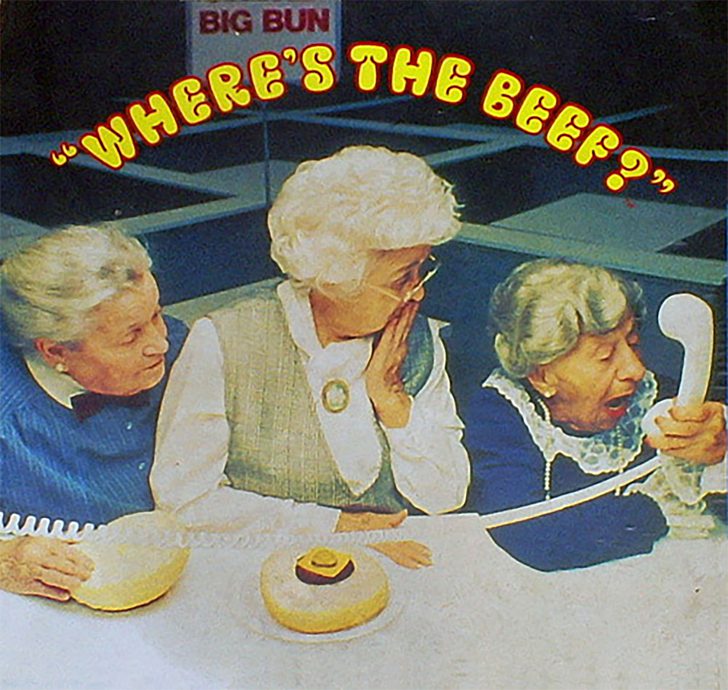
Having a giant hamburger and some cute old women doesn't guarantee the success of an ad, but this gutsy approach taken by Wendy's in 1984 was targeted at the competition. The innocuous catchphrase "Where's the beef?" basically pointed out the missing beef in the competition's burgers. It quickly caught on to mean what customers missed in their lives.
While no one can predict how such a tagline would fare, Wendy's avoided over-promoting its hit phrase, which ran for only one year. The wise and carefully thought-out campaign taught a very important lesson: never overuse a successful campaign since time, and consumer preferences also change.
De Beers | A Diamond Is Forever | 1999
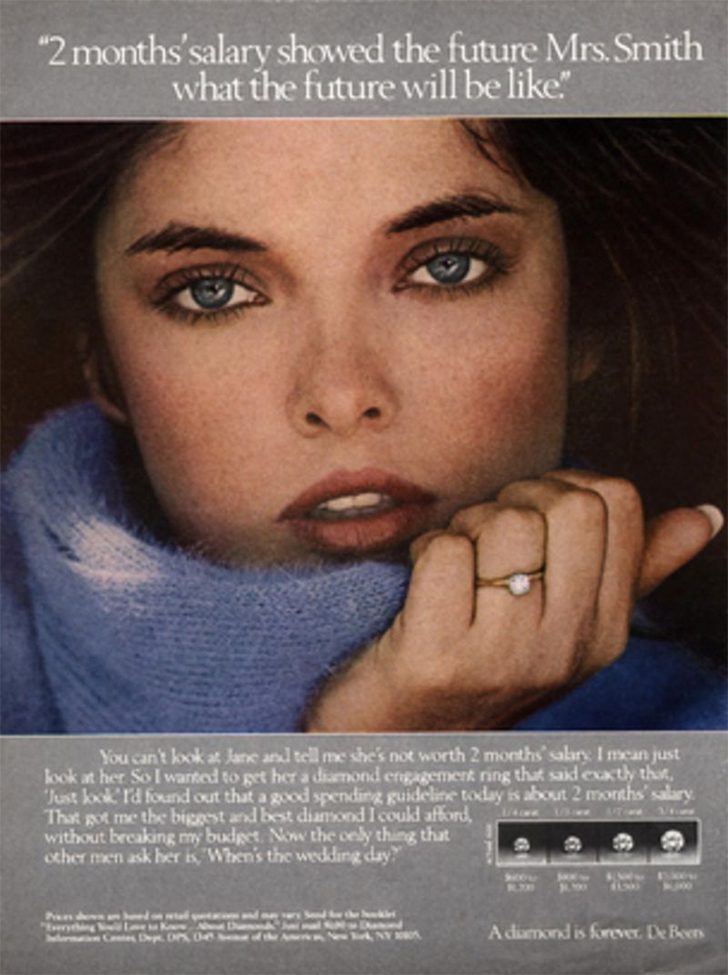
While this De Beers ad carried some pun with it, it was seeking to underscore the importance of having diamond wands at the nuptials. It was meant to push the narrative that no such ceremony would be complete without the jewel. The ad didn't ride on existing industry success but presented the gem as a necessary luxury.
It's no wonder the "A Diamond is Forever" catchphrase was declared the 20th century's most memorable slogan by AdAge in 1999. According to the New York Times, the commercial's creator, N.W. Ayer meant to compel anyone pledging marriage to look no other way than at the jewel.
Clairol | Does She, or Doesn't She? | 1957
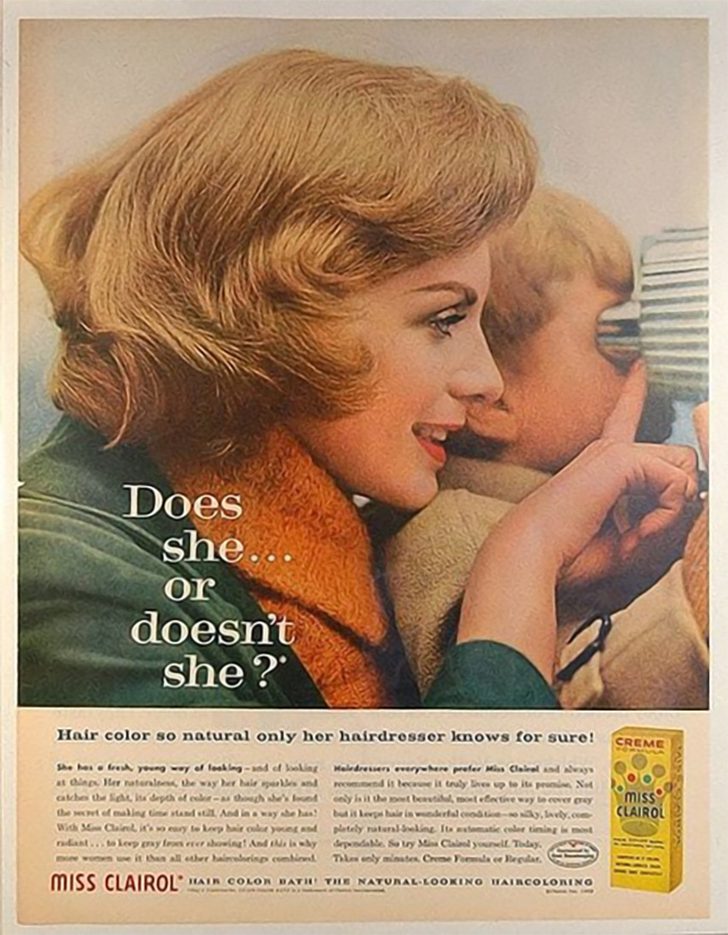
After noticing a gap in the number of women who used artificial hair color, Clairol decided to change the narrative by asking this question. Before the ad came out in 1957, only one in 15 people used artificial locks. According to TIME Magazine, the numbers changed to one in two people just 11 years after the commercial ran.
In fact, the ad was such a hit that some states stopped asking women to indicate their strand color on their driver's licenses. Clairol made women understand how the product was so good that no one could tell who was using it or not.
California Milk Processor Board | Got Milk? | 1993

The simple slogan "Got Milk?" was a marketing campaign spearheaded by the California Milk Processor Board in 1993. It was meant to increase milk sales in California, which actually rose to 7% in one year, with the ripple effect being felt across the state borders. The ad targeted existing milk consumers.
Millions of "Got {fill-in-the-blank}?" parodies still exist, showing how the ad was successful. The board revolutionized marketing with this commercial to show the importance of existing consumers. Businesses need not go all out to hook in new clients while they can get the existing ones to appreciate and use their products.
Volkswagen | Think Small | 1960
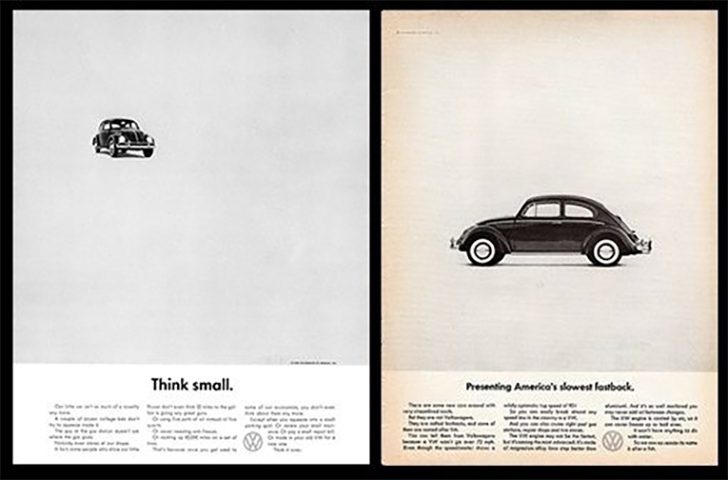
How easy is it to change people's perceptions about a product and others around them? This question was expertly answered by Volkswagen in 1960 through its ad "Think Small," created by the iconic Doyle Dane & Bernbach (DDB) team. There was a need to change Americans' mindsets towards small German automobiles.
So, the German automaker played right into their expectations, sticking to the narrative that its vehicle is small. It didn't try to be something it wasn't, giving businesses the sound advice that it's never about the company, the product, or anything else. The commercial pointed out that consumers identify with and appreciate honesty.
Miller Lite | Great Taste, Less Filling | 1974
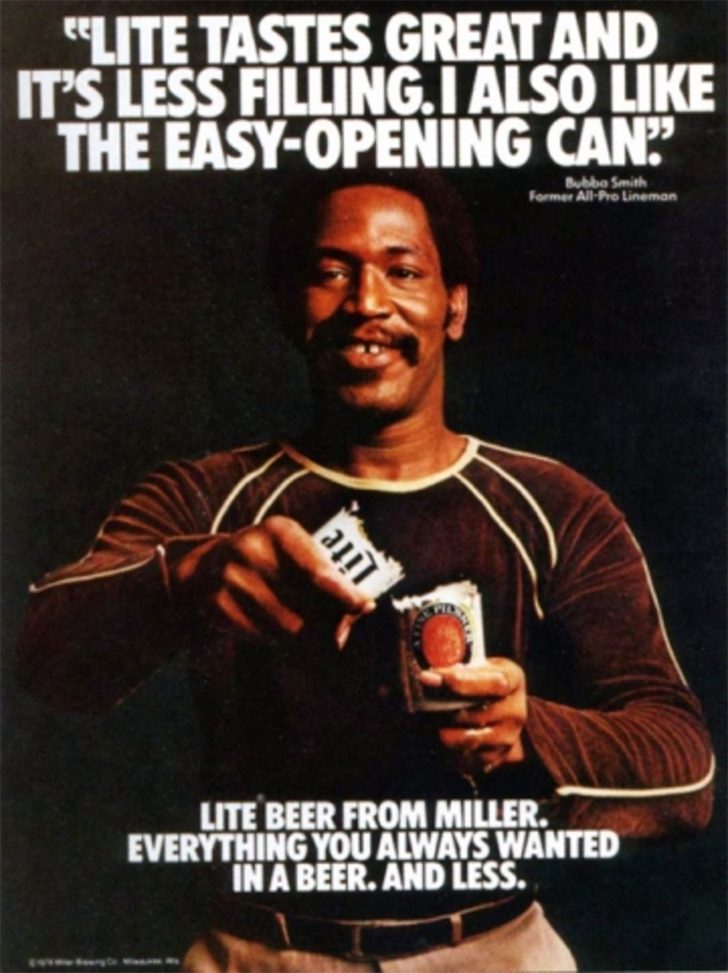
Most businesses strive to be different from their competition, but sometimes they fail to get it right with their marketing, something Miller Lite did well. MillerCoors, formerly the Miller Brewing Company, created a whole new market for its light beer product. There were jitters and misconceptions about "real men" partaking in the liquor.
The brewer decided to run the "Great Taste, Less Filling" campaign using masculine models drinking the beer to show it actually tasted good. For decades after the ad aired, light beer was unbeatable in the liquor market—that was essentially Miller Lite's creation. Well, it's evident that product differentiation leads to market leadership.
Absolut Vodka | The Absolut Bottle | 1986
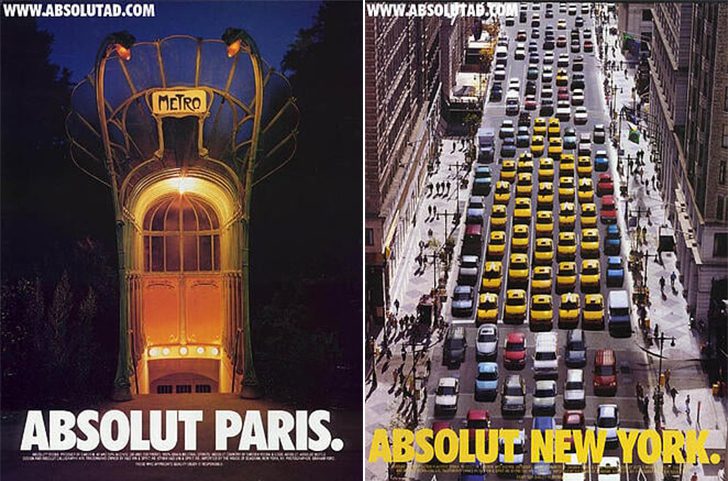
When it comes to a commercial's longevity and effectiveness, none beats the iconic Absolut Vodka bottle print ad that was created by Andy Warhol in 1986. The campaign changed the fortunes of the beer maker from a measly 2.5% vodka market share to importing about 4.5 million beer cases every year.
The no distinct shaped bottles "in the wild" became recognizable the world over, running for 25 consecutive years up to the late 2000s. It consisted of more than 1,500 separate print marketing ads, telling the boring product's story in different interesting ways. We guess this confirms that if it isn't broken, don't fix it.
Nike | Just Do It. | 1988
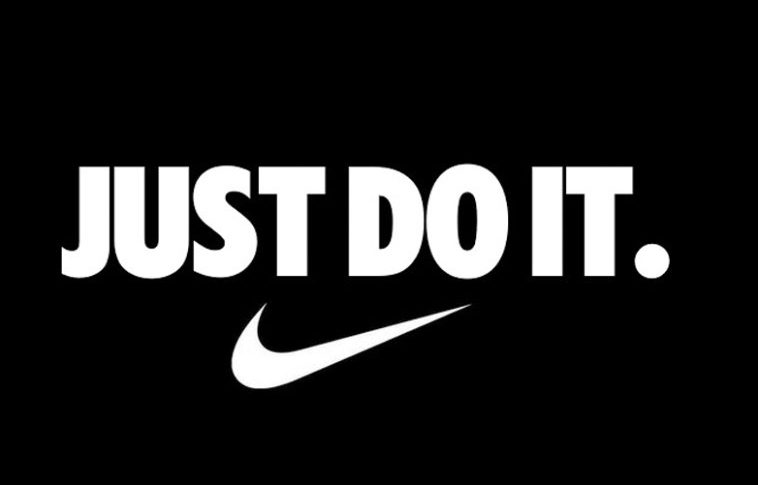
It's hardly believable that there was a time when Nike catered exclusively to marathon runners before the fitness craze came about. The company's marketing department decided to take advantage of the emerging craze to beat its competitor, Reebok, which was selling more sneakers than it did. Wieden developed the "Just Do It." campaign in 1988.
It became a hit instantly, as the company's sales were $800 million that year but had burgeoned to over $9.2 billion by 1998. The short and sweet catchphrase encapsulated every user's feeling when exercising, as it offered a much-needed solution. The relatable slogan helps push us beyond our limits.
Weyenberg Shoes| Keep Her Where She Belongs | 1974
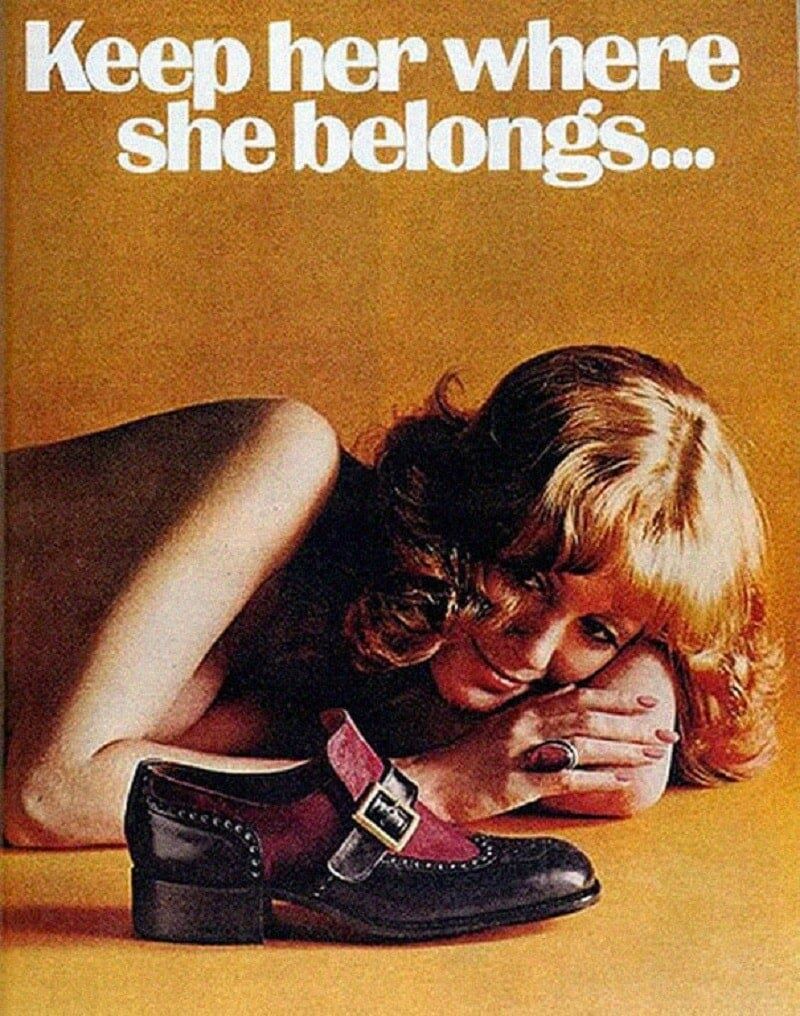
When Weyenberg Shoes ran this campaign in Playboy magazine in 1974, women were still viewed as men's servants and should stay at their feet. It propagated the idea of women being influenced by men's choices and not their own. Well, putting any gender down isn't as funny a joke as this ad meant it to be.
Although the "keep her where she belongs" tagline went with the campaign's theme, it sticks out like a sore thumb. It may have been a 1974 ad, but progress on the equality front has thankfully changed the game so that such ads are rarely seen in the modern world.
Coca-Cola | The Ideal Brain Tonic | 1920s

Coca-Cola has always been known, perhaps not for its products but for its innovative marketing campaigns that change with the times. The company releases new products every now and then, but some of its ads have stood the test of time, like the classic Coca-Cola fridge bottle ad that stands out from the lot.
The iconic global company has existed since the 1890s, and it soon ran a brand in the '20s, terming it a "brain tonic." It was claimed that drinking ice-cold coke would relieve headaches and revitalize the mind and body. Well, the strategy made it a well-established global corporation!
Kenwood Chef | Keep Your Woman in the Kitchen | 1961
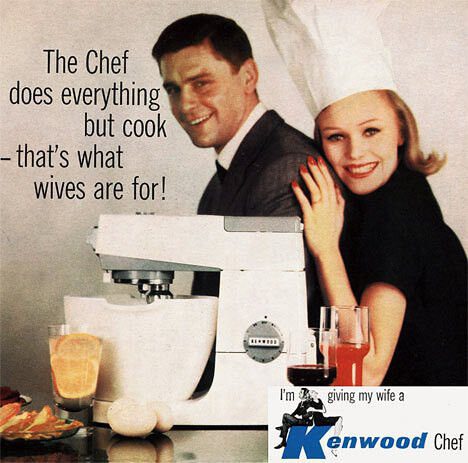
Although this ad may have worked when it came out in 1961, it can't hold much water in the modern world given that it subjugates women to men. It basically highlights men's obvious dominance over women back then, who were expected to have their own space in the kitchen.
This Kenwood Chef mixer commercial fostered gender-based work division as the man was depicted as hard-working while his wife served him as a cook. In fact, we still buy kitchen toys for our girl children and automobile toys for our boys. However, things are changing as both genders are given equal opportunities in nearly all spheres.
Van Heusen | Show Her It's a Man's World | 1951

This list predominantly carries the unfortunate theme of men dominating women, a subject that most marketers never seemed to shy away from in years past. It's disturbing that this 1951 Van Heusen tie commercial made crazy sales at the expense of women's rights. That told a lot about the male-dominated society.
The "It's a man's world" titled ad is, by all means, derogatory, and the woman is portrayed as a subject of the formally dressed man lying in bed being served breakfast. While we would all love breakfast in bed, it shouldn't come at the expense of women's rights but should be served with love.
Odorono | Beautiful but Dumb | 1939
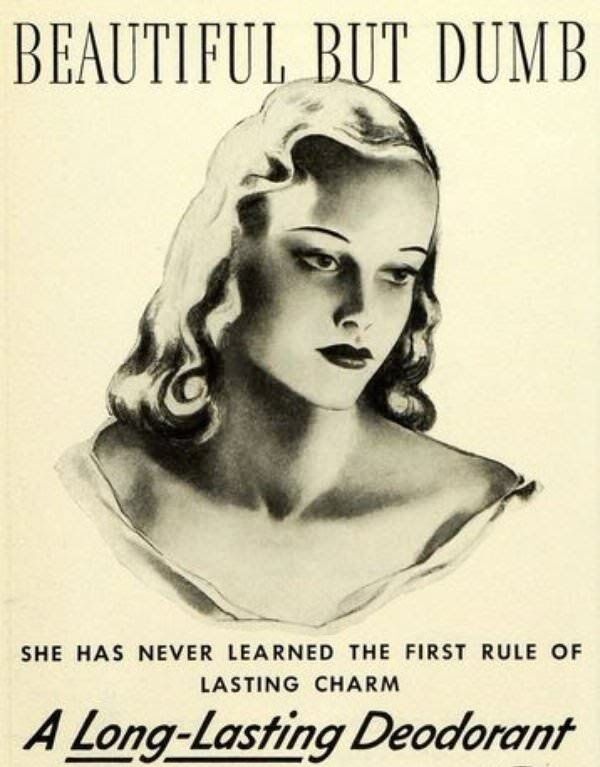
It's hardly believable that most '30s to '50s commercials that made crazy sales rode on mocking women and subjugating them to men. More baffling is that this 1939 liquid Odorono ad was done by a female-owned deodorant company seeking to portray the product as a cure for "excessive perspiration" and not for body odor.
The campaign spiked sales even though it viewed women as "beautiful but dumb" creatures as if their only asset is beauty. Luckily, the picture is different in the modern world, with women viewed as smart and intelligent people. They now take up fairly competitive and well-paying jobs with men.
Parker Pen | Just the Right Size of Pen | 1965
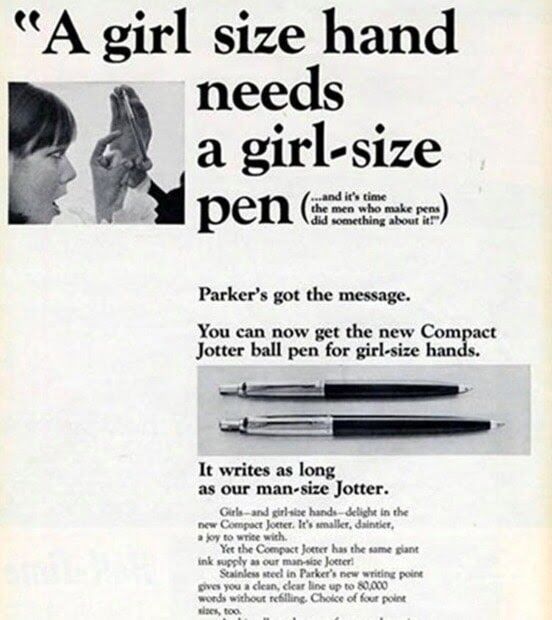
While the '60s were a revolutionary period for many things, advertising seemed to have stagnated, focusing mostly on the differences between men and women and not their similarities. The latter suffered greatly, but this 1965 "A girl-size hand needs a girl-size pen" ad by Parker focused on changing the narrative by being women-centric.
In helping fight for women's rights, barring the ad's language, the company advertised a women's-sized writing pen that was comfortable when held and in writing. The commercial was directed towards empowering women as it depicted them as capable of working. It ignored the idea of women being men's supporters and household chores executors.
Gillette | Begin Early Shave Yourself | 1901
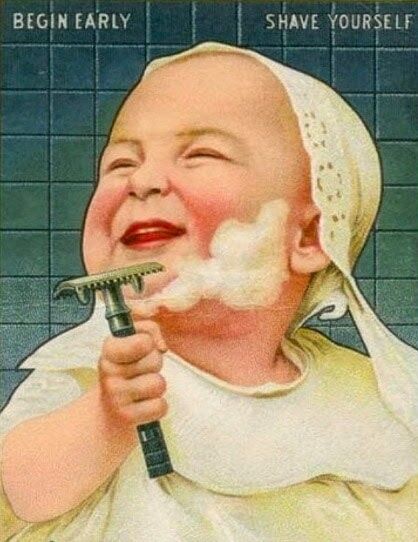
Whatever the underlying concept was, the commercial came across as illogical, let alone making it to the press. This 1901 ad ran by Gillette introduced its disposable safety razor to replace the safety ones which needed stropping and honing. A noble idea to save razor sharpening time, indeed.
The ad was gleefully received at that time, increasing the company's sales tremendously. However, if the same concept were to be employed today, the creatives would likely be chastised. It's not fathomable to force a child to hold a sharp razor, let alone use it, without having possible dire consequences. A toddler doesn't need one!
DuPont Cellophane | The Best Things in Life | 1950s
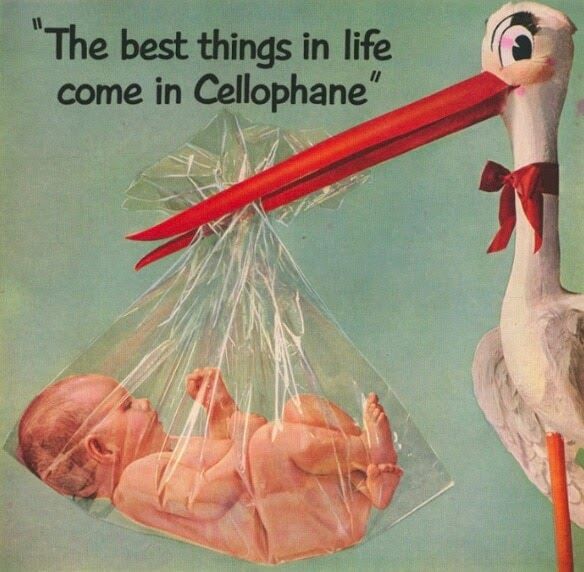
Some of the most successful commercials have used outstanding catchphrases to seep the importance of their products into their clients' psyches. DuPont Cellophane used the same concept in this '50s ad, taking the popular saying "the best things in life are free" and coining it with "the best things in life come in a Cellophane."
The goal was to highlight the importance of scientific fresh-sealing technology that kept fruits and other irregularly shaped objects looking fresh. It was a tight plastic wrap promotion, which would have probably worked with a "strictly for gift baskets" phrase instead of a child transported by a stork.
Alcoa Aluminum | Can a Woman Open It? | 1953
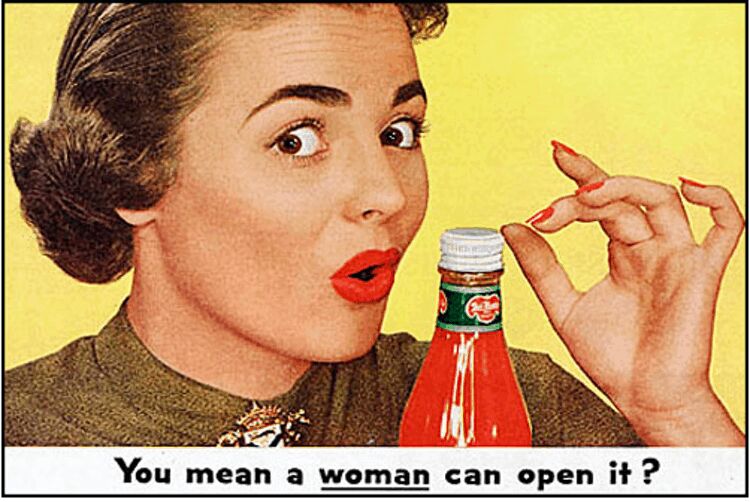
We've all clearly faced difficulties opening some container caps, whether women or men, at some point in our lives. So, it's surprising that Alcoa Aluminum chose this misogynistic and retrogressive concept for this 1953 ad for Del Monte Ketchup. It's good that it was introducing an easy-to-open bottle cap, but the approach was totally off.
The move watered down the meaning of the intended communication as it painted women in a bad light. Ironically, the company failed to recall that these were the same women confined to the kitchen during the same period. Surely, they must have known how to open such bottle caps!
Tengen | Davis Cup World Tour |1993
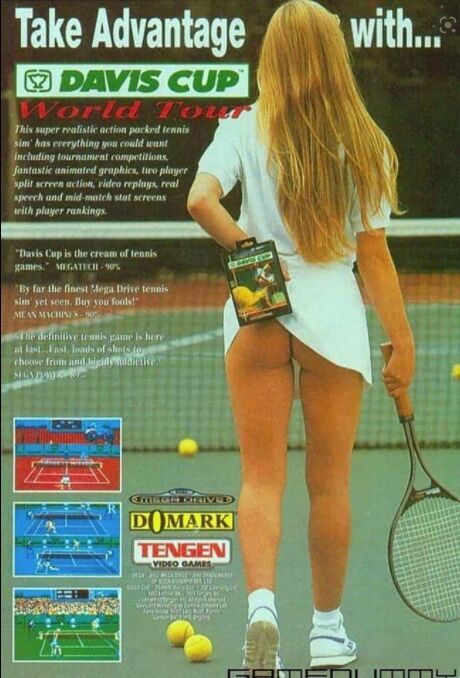
At first glance, this risqué ad would never give an inkling that it was promoting a famous global tennis tournament. Well, it's an '80s computer tennis game that Tengen was promoting as a major game drive back in 1993. The company, then responsible for developing, publishing, and licensing console games, wanted to hook fans in.
It did get many tennis lovers' attention with its huge and bold writing of "Davis Cup," but somehow managed to confuse them more with the girl's picture. Why would a sport like tennis need such a bold move to sell itself? Luckily, advertising has since transformed for the better!
Ashton and Parsons | Say Good Bye to Depression! | 1939
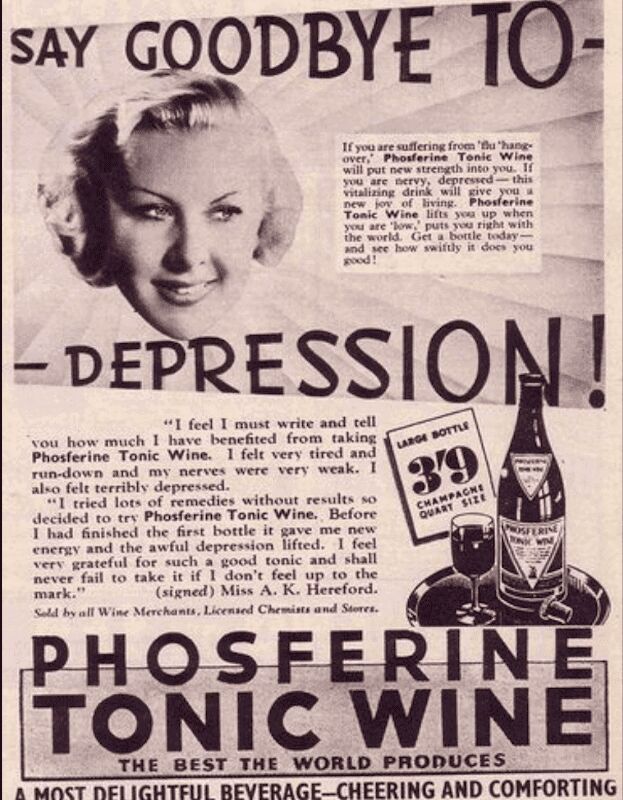
A glass of wine after a tedious day's work is believed to be relaxing, but suggesting it to someone with depression may be the worst medical advice ever. This 1939 ad by Ashton and Parsons called on women to drink a glass of Phosferine tonic wine to kill their boredom and depression.
It seemed to propose that they should do that while waiting on their husbands to return from work, something that has thankfully been buried in the past. Because mental health and depression were rarely discussed at the time, brands made extensive use of the issues to market. Thank the heavens for modern medicine!
Chiquita | Most Flavorful | 1940s
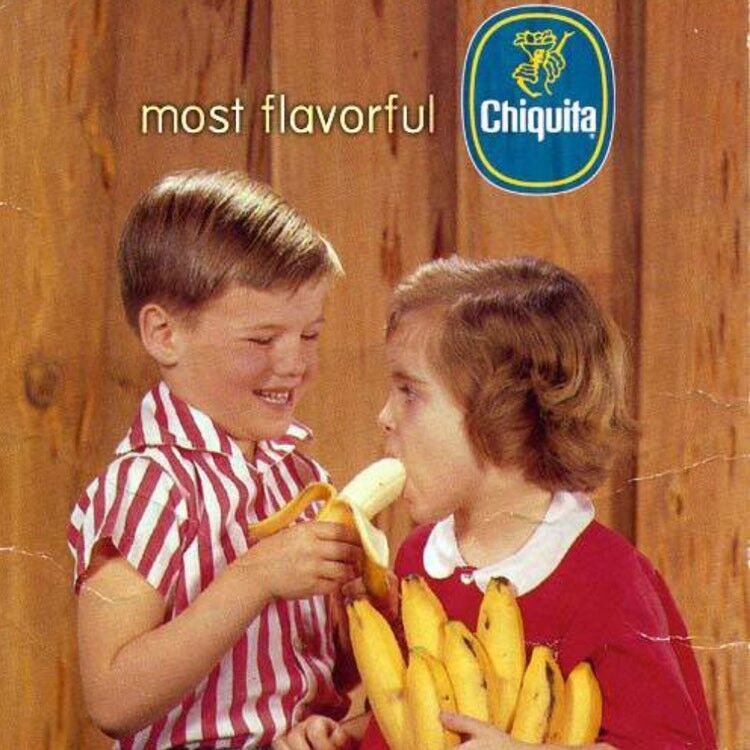
Kids are known to learn best through imitation, so any food company wishing to promote healthy living needs to follow Chiquita's lead. With an understanding that some parents struggled to convince their young ones to eat bananas, this ad went on the air in the '40s. It depicted happy siblings feeding each other while having fun with it.
We must admit that while the commercial helped folks overcome their children's refusal to indulge in healthy eating, some dirty-minded people may have seen a naughty and awkward marketing gig. Luckily, the happy image presented by the boy feeding his sister worked magic in helping Chiquita boost its sales.
Lane Bryant | Free Chubby-Size Clothes | 1952
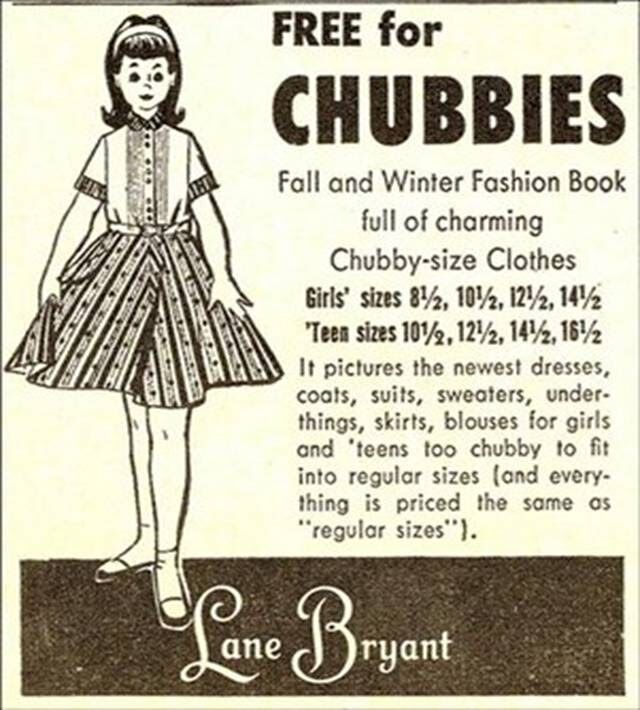
While the modern world requires us to measure our words about many things, there was a time when anything went. It was okay to call people fat, lazy, or even cheap, and marketing companies used such words to place commercials. This 1952 chubby-size clothes ad was run by Lane Bryant to offer several sizes.
Having this specific target market helped to move the volumes, something we're afraid may not hold water today unless a company wants to "hurt people's feelings." Again, there's a general need for ads to avoid coming across as distasteful or insulting, although this one intended to subtly advocate for body positivity.
The General Cigar Company |Front Page with a Difference | 1967
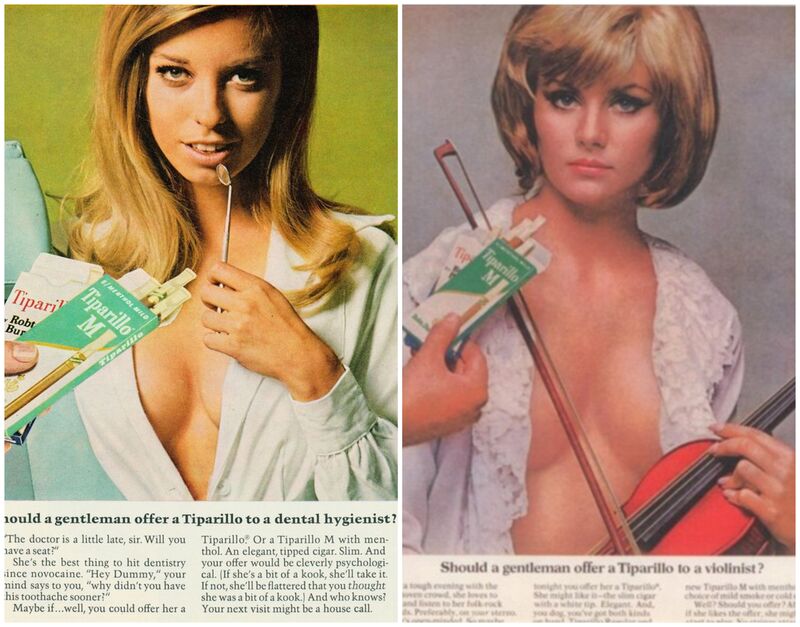
Most companies in the '50s and '60s featured beautiful and steamy supermodels as a common advertising method for their products to lure clients. The General Cigar Company used these gorgeous women with hourglass figures to push its Tiparillo cigarettes back in 1967 and 1968 but in a classically disguised manner.
While cigars were the primary product, the campaign seemed to also promote violin lessons and good oral hygiene. Sadly, not much has changed, with many commercials still featuring hot-looking glamor queens to promote products. The world has taken to glorifying steamy advertising to get consumers' attention in nearly every marketing space.
Agee Pyrex | Kitchen-Brewed Marriages |1950s
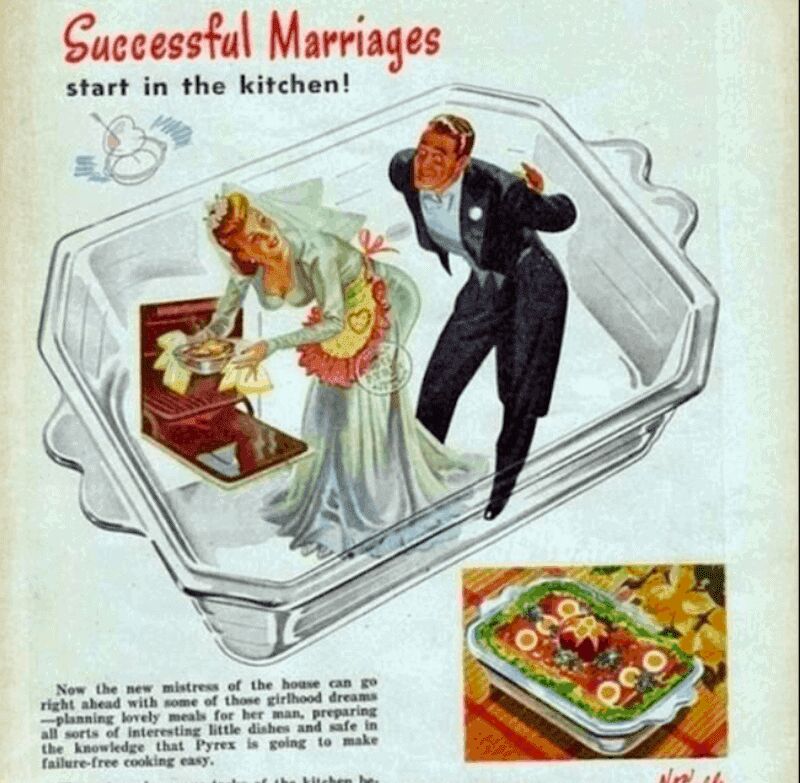
Because it was common practice in the '50s to advertise to women through misogyny, the Agee Pyrex ad followed suit. It took advantage of most girls' wedding fantasies to link it with a successful and happy marriage that apparently comes through buying its kitchen products.
The bait might have worked then, but not in the modern world, not even for this long-standing and well-known company. Its tagline, "Successful marriages start in the kitchen," is strong enough to lure anyone into buying, but it can't grant a long-lasting union. Refreshingly, the ad subtly addressed and advocated for the sharing of roles between men and women.
Fluky |The Depression Hot Dog | 1929
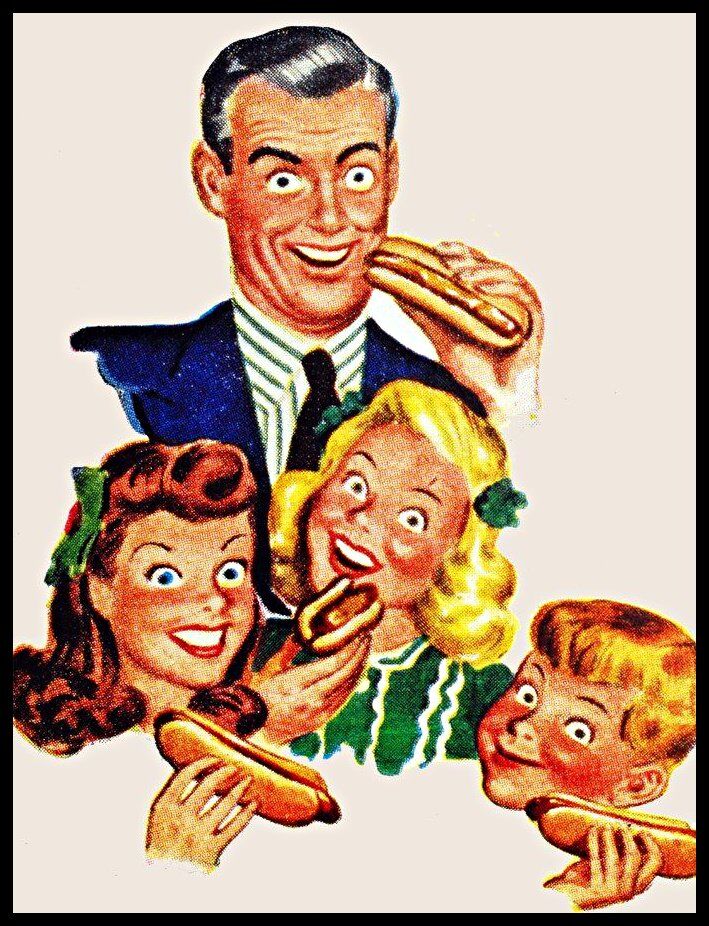
When The Great Depression struck between 1929 and 1939, hot dogs became the go-to meal, becoming a favorite of most families. There weren't many companies producing the wiener, but Fluky was one of them, leading with the sale of the first "Depression Sandwich." It was during that time that this ad ran.
Although the campaign's creator is unknown, the then-nickel-priced meal saved many worried people as dependable street food. Well, this family had their fill of it, going by their faces, but hotdogs have become reliable at sporting events. The meal is simple and easy to prepare and can be taken on the go.
Kraft Foods Limited | You're Eating a Pony! | 1950s
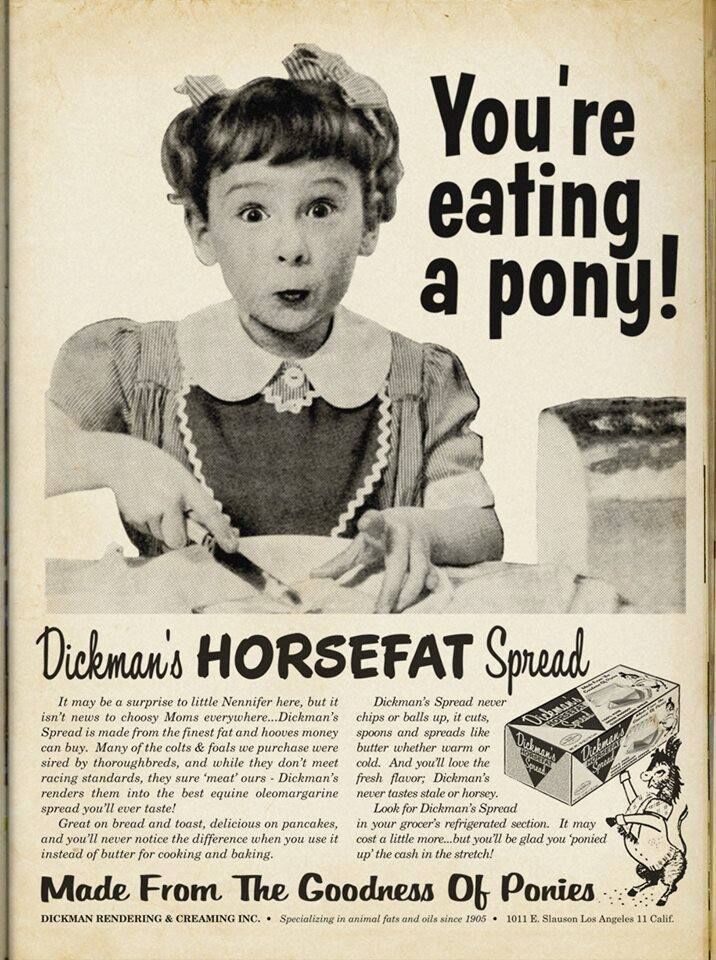
In the '50s, Kraft Foods Limited ran an ad to push its Kraft margarine using the catchphrase, "If you didn't know better, you'd say "butter"!" The commercial helped the bakery increase sales significantly. However, in 2016, an artist by the name of Shapan recreated the ad and made it comical (this picture), making it go viral.
While many don't know that it's a fake campaign, it would appear that Dickman Rendering & Creaming Inc. is pushing its Dickman's Horsefat Spread in an orthodox way. It's an insightful idea, though, since kids love ponies, unicorns, and horses, so they'll ideally push their folks to buy the product.
Valery Barykin | Soviet Pin-Up | 2003
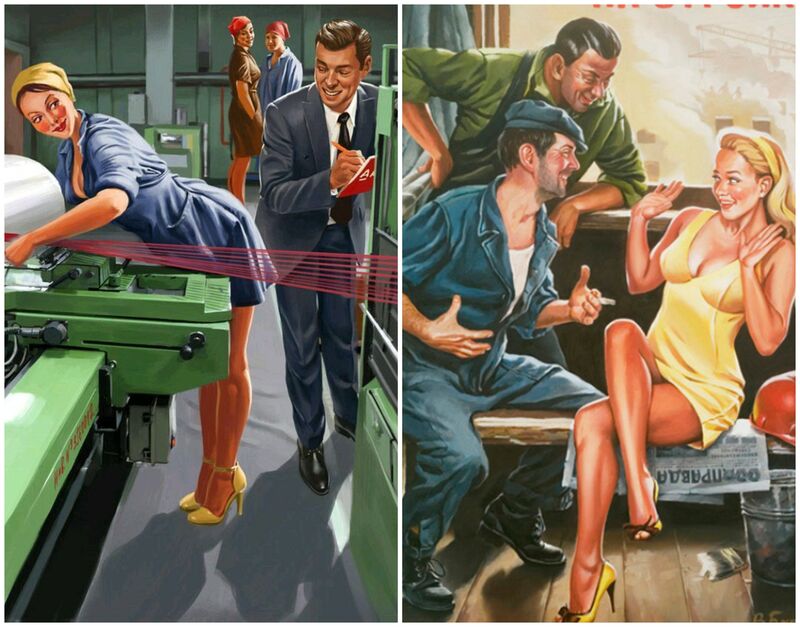
Russian military-bred artist Valery Barykin is the mastermind behind these creative masterpieces used to describe the differences between Russian and American cultures. The predominant women caricatures, mostly created in 2003, focused on showing sensually liberated American women while extolling the values held by communism in the former Soviet Union.
While one man is taking notes from the woman on how to thread the loom, the other two seem to be flirtatiously encouraging the woman to join them at the construction site. The scantily dressed women, clearly objects of attention, display an unexpected daily situation as they enthusiastically go about their usual stereotyped duties.
Pitney Bowes | Can I Kill a Woman? | 1953
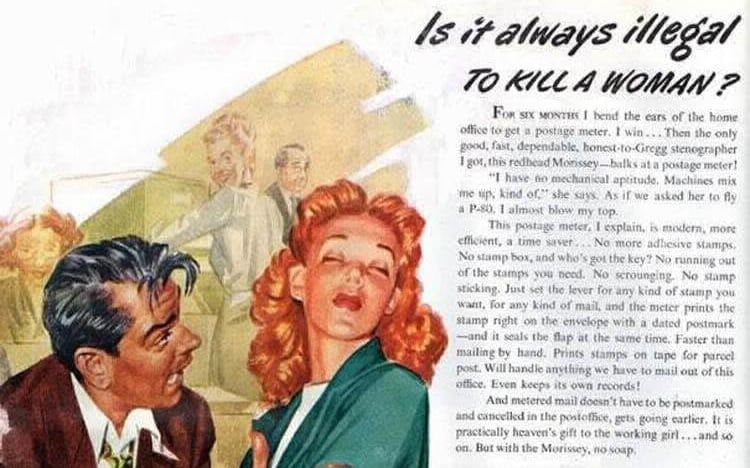
While it's illegal to kill a woman, it may make sense to kill a misogynist copywriter. Just kidding! But social constructs that dictate how women are supposed to behave or look have greatly contributed to casual misogyny. The act is always expressed by supposedly harmless statements, actions, or behaviors that are nonetheless bad.
This 1953 ad by Pitney Bowes depicts the difficulty this man had in convincing this woman to buy his product despite her believing it wouldn't fit her needs. She did come around to giving it a try, and as it turned out, it was an adorable item. Well, persistence pays.
DuPont | Sun Bathed Baby | 1930s
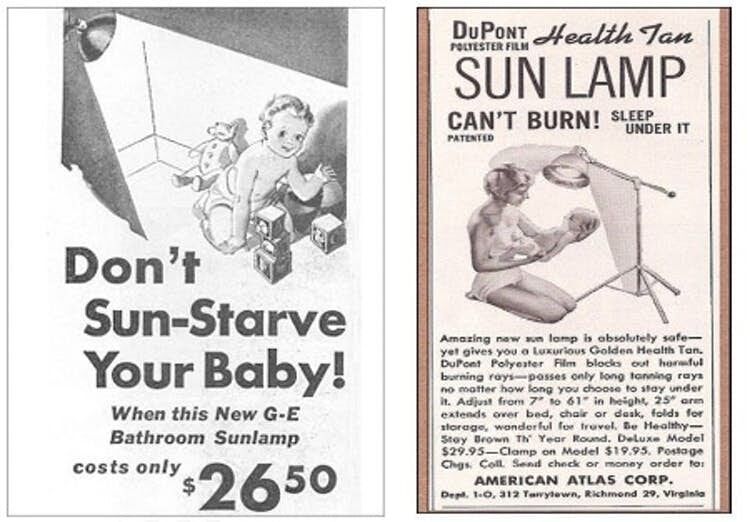
Vitamin D is very essential to children's growth, especially for strengthening bones and preventing rickets, and it's readily available and free from the sun. In the '30s, DuPont developed a sunlamp bed that it claimed would provide nutrients to children while they slept. To push it onto the market, it ran this campaign targeting parents.
Granted, mothers, fathers, and guardians are easy targets for companies selling kid-related stuff, but pushing to such levels is a step too far. The scenario is different today, where children spend most of their time on the computer, missing out on this free natural resource, unlike in the '30s.
Pennsalt | The Goodness of DDT | 1947
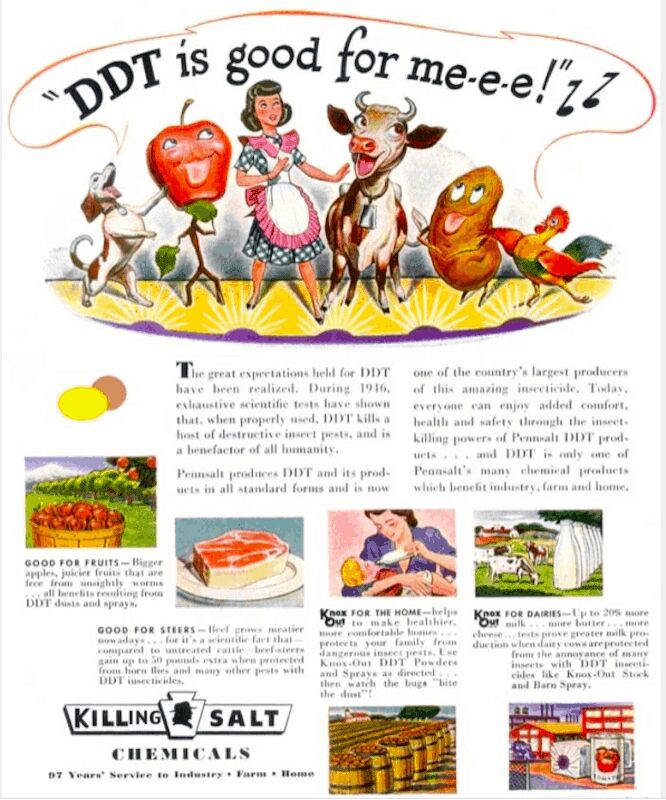
Ignorance has never been bliss! In 1947, Pennsalt ran this marketing campaign, trying to convince potential consumers that the chemical dichlorodiphenyltrichloroethane (DDT) was a good product. In essence, it's a tasteless, colorless, and odorless preservative with the potential to cause harm. It was primarily used to preserve meat, dairy foods, vegetables, and other perishables.
DDT is extremely harmful to the environment because it had lethal effects on the world when it was in use. Here, the company is pushing it as a clean product, which leaves a lot to be desired given that it dabbles in growing and making a variety of food.
Brown | It's a Wifesaver! | 1973
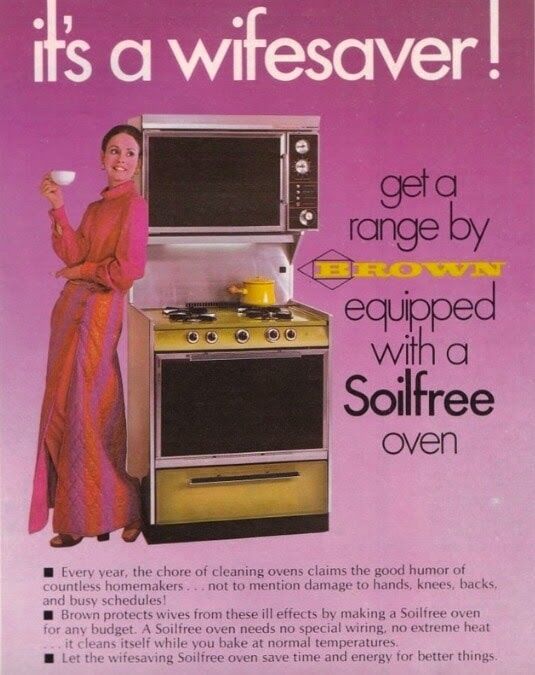
Going by this 1973 campaign by Brown, anyone thinking of spoiling their wife with all things jewelry may be dead wrong. The "It's a Wifesaver!" tagline rightly calls on men to make their spouses feel at ease while handling their usual house chores. It challenged both genders when the clamor for equality became a burning issue.
The promotion didn't succinctly encourage men to handle house chores, but it triggered a step towards caring for women. In the ad's footnotes, men are basically being challenged to spoil their wives by making their work in the kitchen simpler and saving their energy for other, better things.
Prof. Eugene Mack | Curves of Youth | 1890
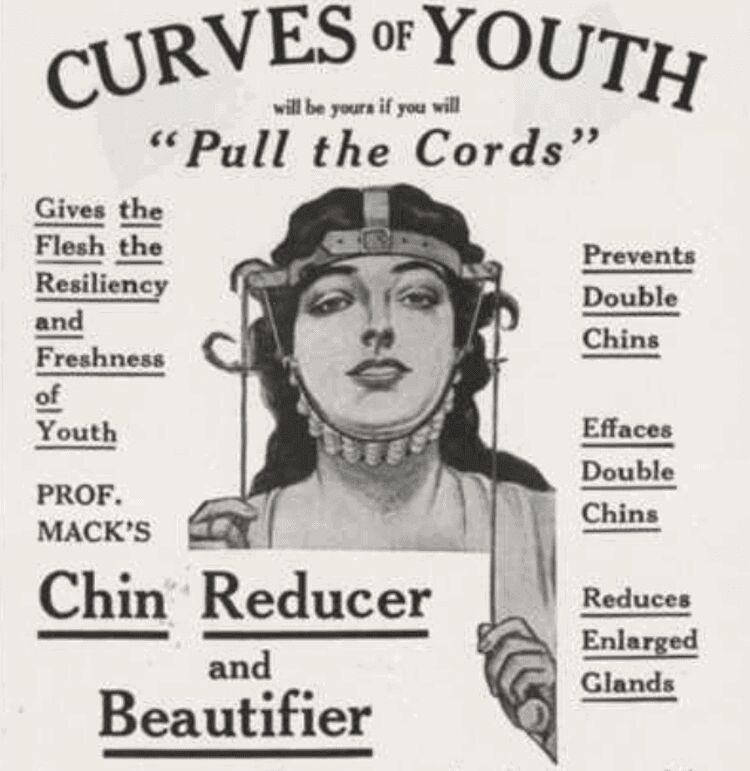
For some women, beauty comes at a cost, and they can easily be lured into buying products they don't necessarily need. This 1890 campaign by Prof. Eugene Mack best describes what women would go through to get and maintain that lost youthful look. They only needed to pull the cords of this chin reducer and beautifier.
While we can't say whether this antiaging skincare gadget worked, we're certain it's no longer in use given the significant improvements in that sector. New and revolutionary beauty products have emerged so that women don't need to go through torture to strike that much-desired glamorous and graceful look.
Hardees | Women Don't Leave the Kitchen! | 1940s
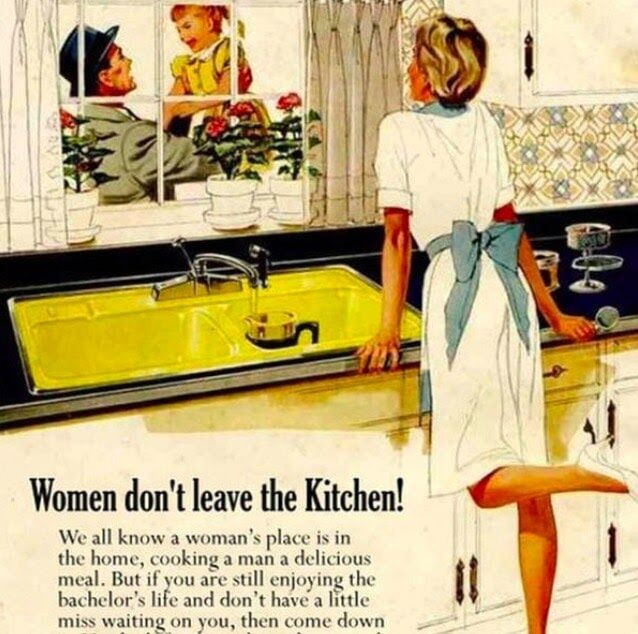
Centuries have passed, but the age-old stereotype of "Women don't leave the kitchen!" still lives within our systems. This '40s ad by Hardees best describes the sad situation that would raise an uproar today. It suggests that women are good cooks, so the kitchen and taking care of the home are their places, while men are seemingly pathetic at it.
Fortunately, conservative society's barriers to women's equality have since been broken down, with more women taking on equal roles with men. Serious re-learning has taken center stage, with more people acclimatizing to sharing responsibilities at home as equal partners. The centuries-old stereotypes have burst open.
Gil Elvgren | Saucing Naughtiness in Picnic | Unknown

This classic and iconic Gil Elvgren image of a Disney pin-up girl mirrors the artist's work that often played with emotions of innocence and reliving the past. The American pin-up girl painter was famous more for his ingenuity with the pin-up posters than for his ability to generate unique and relatable paintings.
This naughty girl saucing it up at the picnic is one of his many internationally acclaimed, uncanny paintings depicting women in everyday situations. Elvgren had a witty creative trait he majorly used to produce these artworks between the '30s and '70s when there was no known artist with such creative abilities.
Odorono | Selling Shame and Fear | 1943
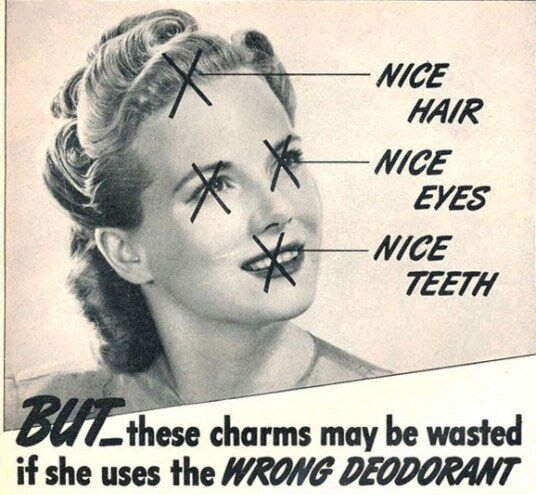
Today, pretty much everyone wears deodorant, but there was a time when it was a luxury that companies had to advertise to sell it. However, the manner in which the businesses composed their advertising messages was demeaning to women. Their lives were basically lived for men, with constant pressure to be beautiful and dutiful.
Although fear-based marketing still works well, this 1943 ad by Odorono targeted women's insecurities quite extensively to bait them. It pushed the narrative that no woman would be up to the mark, however pretty she was unless she used its deodorant to smell nice. Many found themselves buying the most expensive scents.
Retro-Motoring | Effortless Driving | 1960s
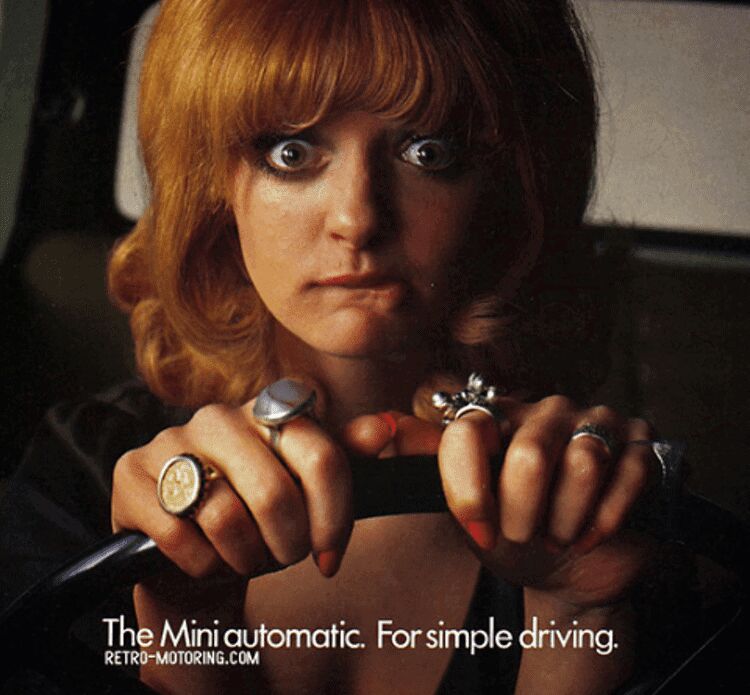
Road safety is a non-negotiable matter, so it looks like Retro-Motoring considered that when it released this ad in the 1960s. Well, the automaker used legendary actress Goldie Hawn to show its potential female clients that it had produced a friendly mini-automatic vehicle that could drive itself even if they fell asleep behind the wheels.
The campaign may have been thoughtful towards having women buy and own automobiles, but it undignified them in the end. This happened at a time when women were coming out of their four walls, but men seemed hesitant to let them out of the cage, let alone drive.
Kentucky Fried Chicken | KFC Is a Wife Saver! | 1968
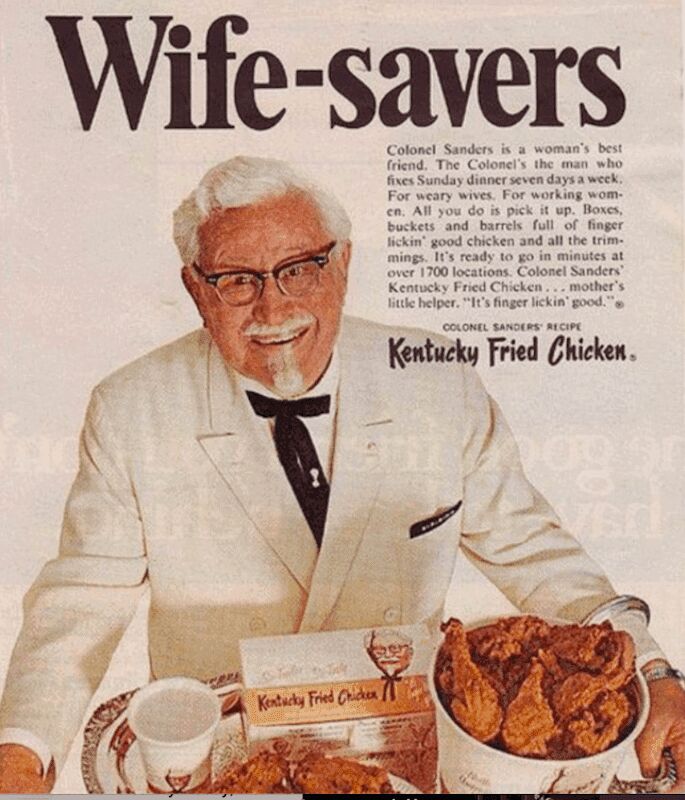
Colonel Sanders, the owner of Kentucky Fried Chicken (KFC), wanted to position his fast-food joint as a savior to working and weary women. Unfortunately, this ad, which ran in 1968, did what most companies were doing during that time, which was to demean women. He wanted to give them a night off from cooking for their husbands.
Instead, it noted that their place was in the kitchen, but it still gave credit to working women, which pointed to its recognition of the changing times. Refreshingly, KFC's marketing concept became a wake-up call for women to take a break without feeling guilty about being liberated.
Iver Johnson | A No Childs-Play Revolver | 1904

Revolvers aren't items to be left lying about, especially around children, so it's perturbing to see this one in an ad run by Iver Johnson in 1904. The company that used to manufacture bicycles, firearms, and motorcycles pushed the lines too far. Sadly, this wasn't its first worrisome ad with a scary graphic.
Perhaps it was such extremes that made it operate from 1871 to 1993 before closing shop. It intended to show how safe the gun was in a baby's hand, but there are other safer ways to advertise than its approach. It'll be taken in bad taste today given the rising gun shooting incidences.
Palmolive | Beautiful or Clever | 1924
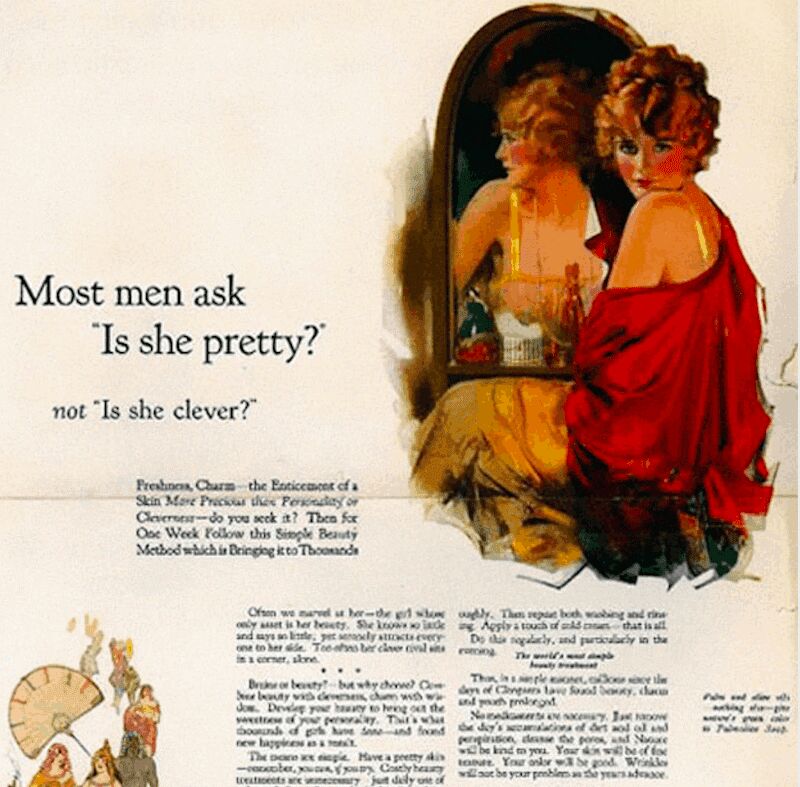
As has been the norm with most ads on this list, Palmolive carried on with the theme of men looking down on women, preferring their looks to their brains, with this 1924 campaign. The company was pushing its beauty products on women, encouraging them to focus on their looks and become attractive to men who were potential husbands.
According to the brand's marketing concept, men would not look for what women could bring to their marriage in terms of brains. Companies sold to women deep-seated insecurities that society had somehow propagated, so they also bought the fear of looking pretty to please men.
General Mills | One Task for Two Different Results | 1970
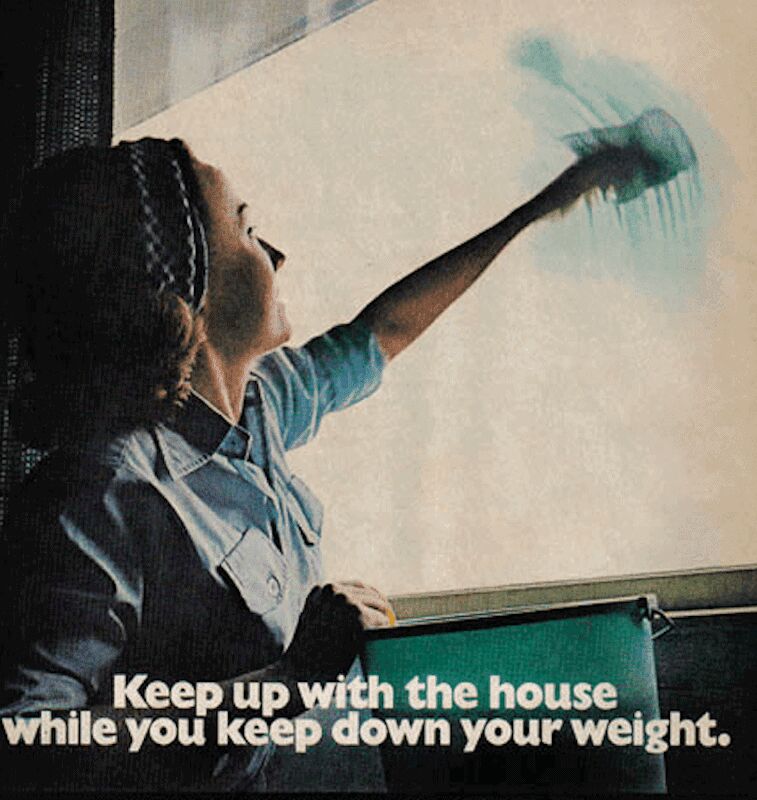
Some people are good at multitasking, such that they can clean the house, wash clothes, and do other chores simultaneously. While that's a rare trait, we think General Mills overshot the reality with this 1970 ad. It claimed that anyone who ate its Total cereal would shed weight while cleaning the house.
The chosen tagline implies that when one is busy, their health improves, but the task attached to gaining that good health isn't ideal. Again, this campaign lures women into undertaking housework, believing that it'll make them thin. Despite the apparent energy it provides, such a commercial would not be acceptable today.
Bell & Howell | Practical Image Projection | 1959
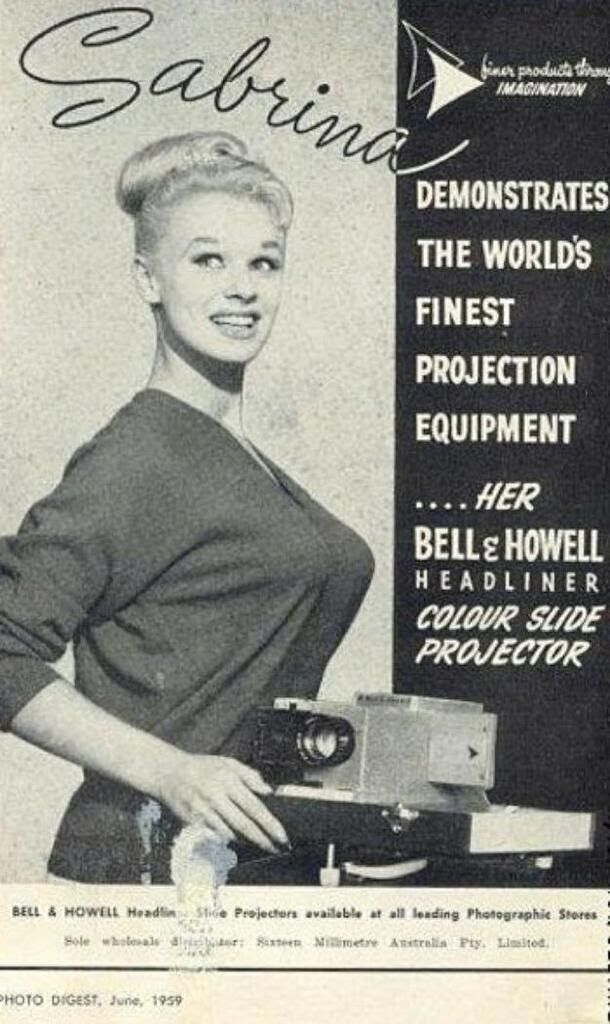
For a promotion to succeed, the demographics need to be better than the ad itself since "a picture speaks a thousand words." That seems to be the secret Bell & Howell used in 1959 to lure men into buying its headliner color slide projector. All it had to do was provide a visual representation of the machine's performance.
By projecting the woman's protruding burst and assets, the company objectified her to men, who probably resonated with the machine immediately. It's a given that the beautiful Sabrina will draw men's attention, but the product's scaling is quite off, leaving much to be desired about the whole concept.
DuPont | Kids Energy-Giving Candy | 1950s
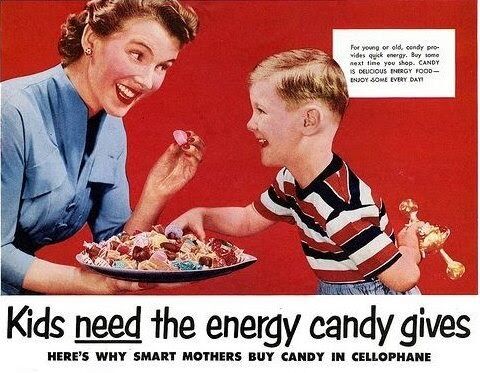
Candy is lovable, and it's not a preserve of kids only, but parents are all too aware of the dangers that high-sugar products have for their kids. Sugar is a delightful pleasure, hence the saying "high sugar rush," but it can cause quite a significant energy increase followed by an immediate sharp energy drop in kids.
In this '50s ad, DuPont tried to indicate that only smart women would think of using its product, cellophane, to wrap candy for their children. Granted, the company was trying to make itself more visible in the market, but it demeaned mothers while selling potentially harmful products to kids.
Delta Airlines | Glamor in the Sky | 1966
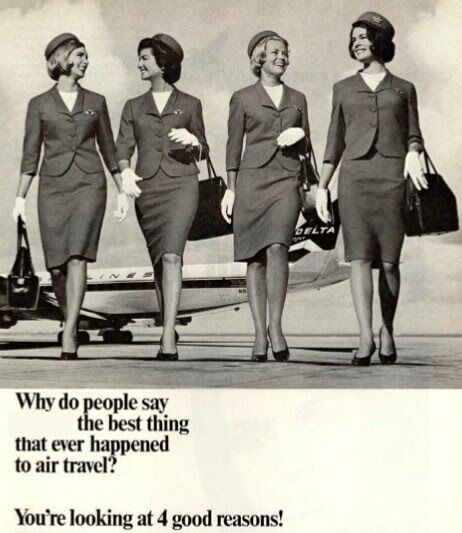
For ages, it's been taken that women make the best air stewardesses, so naturally, every airline uses them in their ads to push their agenda. Delta Airlines wasn't left behind in 1966 when it ran this advertisement encouraging people to use its services, which included these four glamorous women.
The campaign appeared to objectify women as men's property who should provide whatever service they requested as long as the sales came in and flights were fully booked. While we recognize that it was a unique selling point, the airline could have also upgraded its facilities, reduced travel prices, and changed flight schedules to compete.
Searle & Co. of Canada Ltd | Breakfast on the Cards | 1959
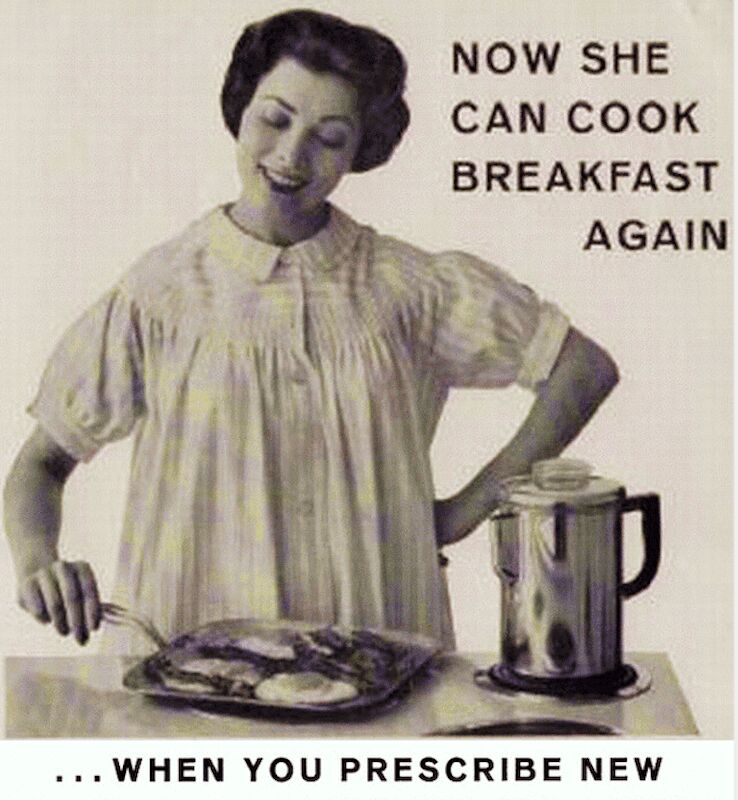
While breakfast is the most important meal of the day, pregnant women often find it quite a challenge to make it due to nausea brought on by some of the needed ingredients. So, in 1959, Searle & Co. of Canada Ltd. ran a campaign promoting Mornidine, a brand of pipamazine, claiming it addressed the problem.
The thought was quite noble, but the misogyny used in the ad was out of place. Again, the medication turned out to be toxic to the liver, and in 1969, the product was removed from the U.S. market. It pushed for a healthy woman to prepare the morning meal.
Colgate and Company | Men Are Funny That Way | 1942
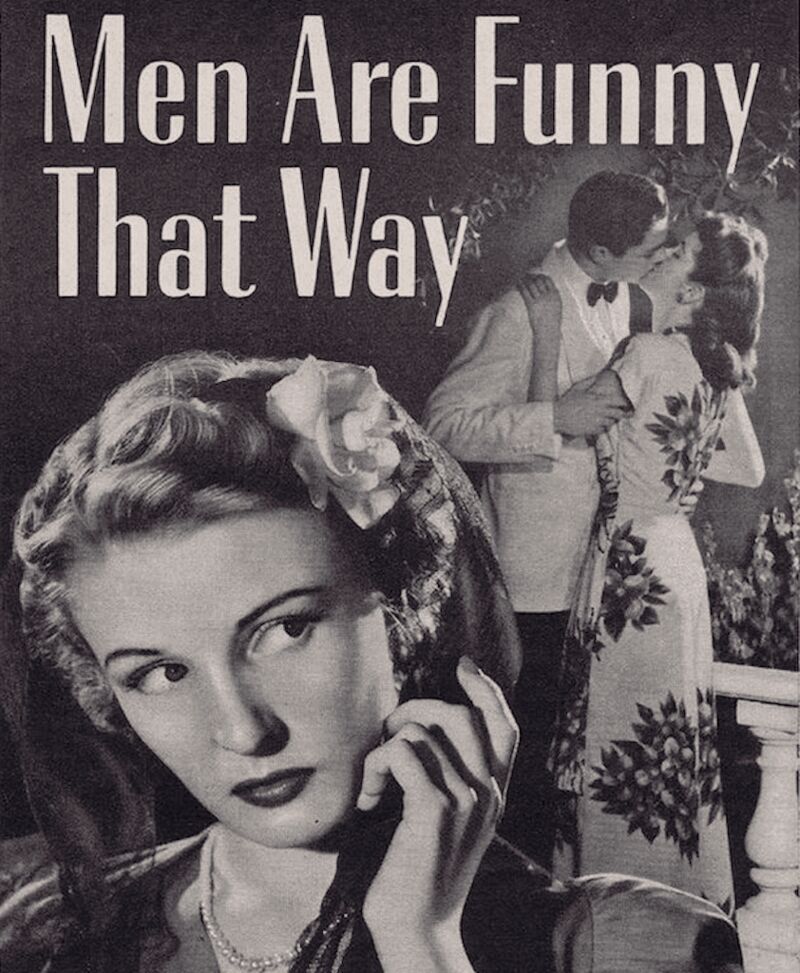
Most marketing creatives use the demographics of attractive women to target men in their commercials, while quite the opposite approach is used to approach women. Warnings and scary messages become the norm if a woman doesn't find a man to marry her. The narrative is that they didn't use a specific product.
In this 1942 Colgate and Company campaign, it's implied that this woman lost her man to a less attractive one because she did not use Colgate Ribbon Dental Cream, even though she was far more attractive. The catchphrase "Men are funny that way" implies adultery is plausible in many circumstances.
Unknown | Catch Your Man… | Unknown
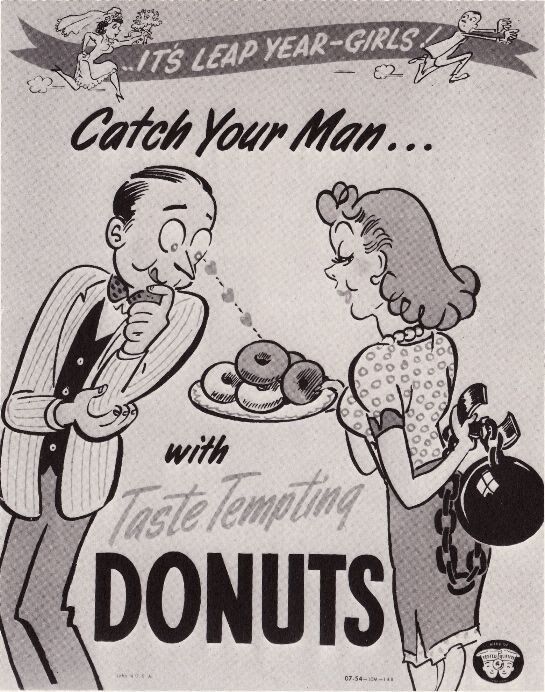
Women used to live to marry and serve men, as many vintage commercials depicted through the marketing of various products. Fortunately, things have changed, and many women are now free to work in jobs that men do. This undefined ad seems to promote the adage, "A way to a man's heart is through his stomach."
It's calling on women to grab their men while they still have the chance. Oddly enough, the image portrays the heavy representation of men afraid of getting married, seeing it as a trap, as represented by the chain and ball behind the woman. Everyone fears being caged, but who's going to turn down donuts, anyway?
